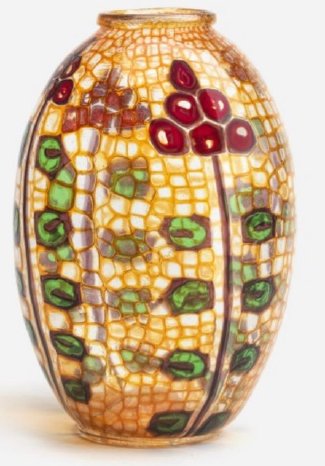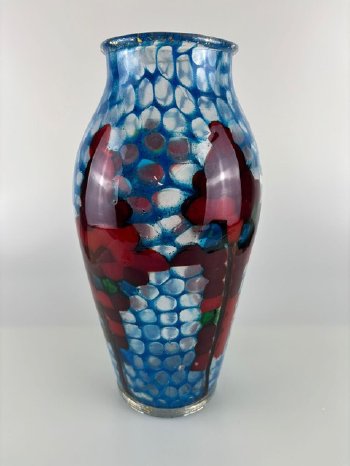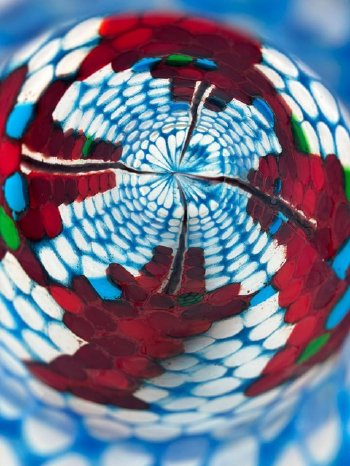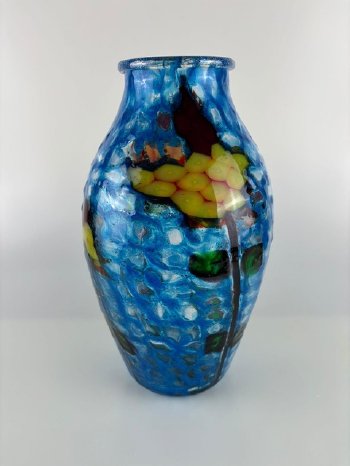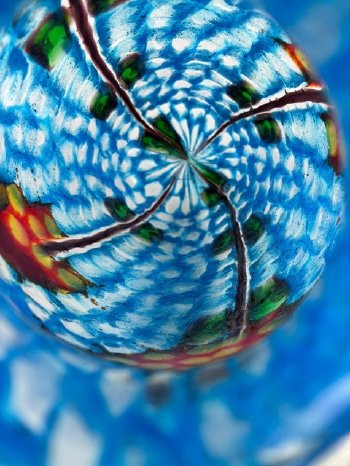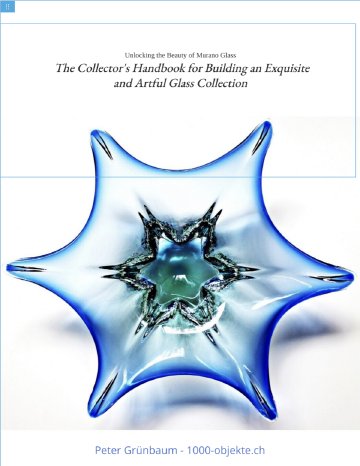The Barovier family has played a vital role in shaping the history of glass art on the island of Murano and has developed the craft throughout centuries. Barovier & Toso, one of the oldest companies in the world, has its roots in 1295 and is known for its outstanding glass works, especially for the “mosaico” technique. This technique is a prime example of the technical and artistic expertise associated with the Barovier name.
The “mosaico” technique, in which small pieces of glass, known as "murrine", are assembled into artistic mosaics, requires the utmost precision and craftsmanship. The murrine are made from glass rods that are melted in different layers and then cut into thin slices. This technique creates complex patterns with intense colours and fine details that are visually and technically impressive.
A “mosaico” piece of work is created by heating the murrine on a flat surface until they bond. The mosaic is then attached to a glass bubble, which is shaped by skilled glassblowers. The success of this process depends on precise temperature control: If the heat is too high, the pattern may be distorted; if it is too low, the glass pieces will not melt properly. This process underlines the outstanding skills of the glass artists at Barovier.
The “mosaico” technique is not only remarkable from a technical point of view but also in its artistic diversity. The colourful patterns can be created in a wide variety of shapes and designs - from floral motifs to abstract compositions. This versatility allows Barovier to combine both traditional and modern styles, and mosaico works can be found in renowned collections all over the world. The way these glass works capture and reflect the light gives them a dynamic quality that enhances their visual appeal.
Barovier & Toso combines tradition and innovation.
Despite centuries of knowledge, glass masters are still able to create new interpretations of the mosaic technique. This continuous development is reflected in the innovative shapes and colours, which range from classic vases to modern sculptures. The influences of the Italian Renaissance can also be seen, particularly in the detailed mosaics, which are reminiscent of the historical works of art from this period.
Peter Grünbaum, a dedicated collector of glass objects for more than 30 years, had the mosaic objects in his extensive collection critically examined by the renowned expert Giancarlo Tosi, himself born in Murano and one of the most recognised master glassmakers. His judgement confirms the collector Grünbaum and emphasises the uniqueness of the objects: “When I saw these rare mosaic vases, I was thrilled, because you immediately recognise the characteristics of the original pieces, the 'dirty' glass. Back then, the ovens were fired with wood and coal, so the glass mass was contaminated with the carbonaceous residues from combustion, ash and lapilli, which formed all these microbubbles. A few years ago, I happened to see a pair of mosaic vases that had only recently been made. They were completely different: The murrine were all square and the same as on an OCCHI vase from Scarpa. The glass was completely clean and clear, the surface perfectly smooth. In short, you could clearly see that they were copies. Congratulations on your purchase!”
Mosaico: a unique legacy spanning eight centuries
The long history of the Barovier family begins with Jacobello Barovier, who was born in 1295 and is considered the founding father of the glassmaking family. In the 15th century, his descendant Angelo Barovier developed the famous Cristallo glass, which was considered to be particularly clear, colourless and transparent. This invention set new standards in the art of glassmaking and cemented the family's reputation as pioneers in this field.
After Napoleon's conquest of Venice in 1797 and its subsequent control by Austria, glass production in Murano suffered greatly. However, the knowledge and techniques of the Barovier family have been preserved. With the reunification of Venice with Italy in 1866, glass production flourished again. During this time, it was Antonio Salviati who revived the craft and gave the Barovier brothers the opportunity to develop their art further.
In 1896, Benedetto, Benvenuto and Giuseppe Barovier founded the company “Artisti Barovier”. Giuseppe was considered one of Murano's most outstanding glass artists, particularly for his work using the mosaic technique. After the First World War, Nicolò and Ercole Barovier took over the management of the company, which was renamed “Artistica Barovier” in 1919. Ercole Barovier was exceptionally creative in managing the company and launched the famous "Primavera" series in 1929, whose glass pieces stood out due to their thick, transparent walls with a network of bubbles and cracks. This technique could never be imitated, which makes the works in this series particularly valuable today.
The works of Barovier & Toso, especially those of Ercole Barovier, still fetch high prices at auctions to this day. A vase by Ercole Barovier from 1930 was sold at auction in 2014 for 317,000 US dollars, underlining the enduring value and importance of these works of glass art.
Barovier & Toso remains a symbol of the fusion of tradition and modernity in the art of glassmaking and continues to set the standard for excellence in craftsmanship. The “mosaico” technique, with its combination of technical sophistication and artistic innovation, is a central element of the legacy of this extraordinary family.
